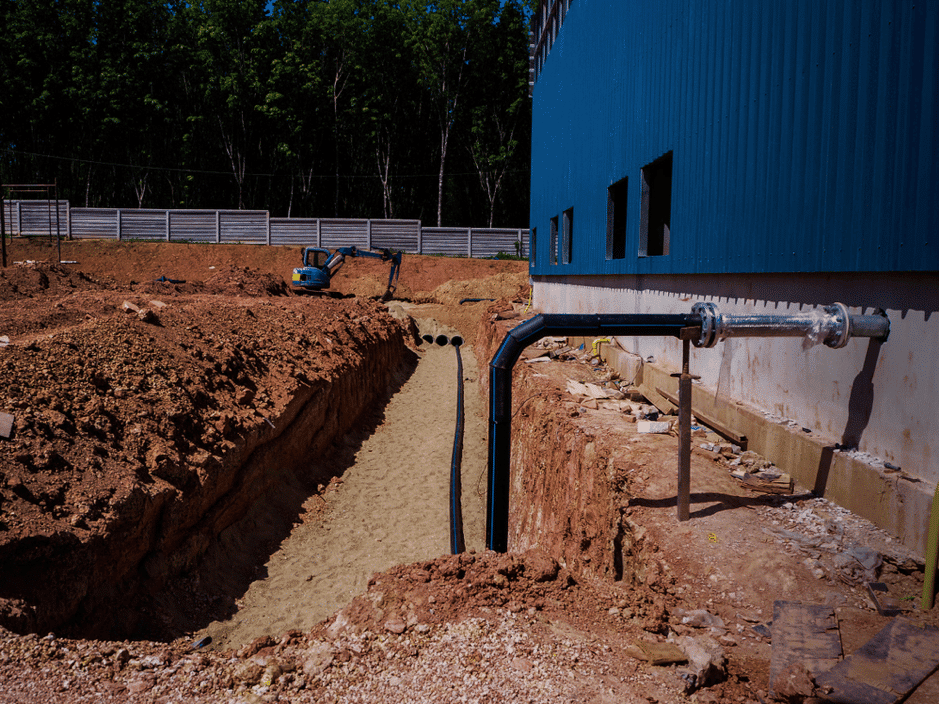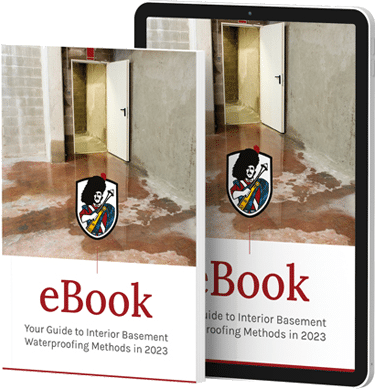Your home is one of your biggest and most valuable investments. Some homes are positioned in areas where the groundwater is likely to build up in the soil which can cause the water table to rise. What does this mean? It means that hydrostatic pressure can be created which pushes on the foundation walls and can force water through cracks. This water seeping in can lead to the cracks expanding and even more water entering your home. If your home is built at or below ground level you must ensure that water is not surrounding the home.
How can you prevent this? It is important to keep your property safe and one way to do so is by ensuring that your weeping tile system is functioning properly and keeping your basement happy and dry.
What is a Weeping Tile?
Weeping tiles are also known as Drain Tiles. They work by collecting groundwater from the area around your structure and moving it safely away from your foundation. The water it moves could be anything from natural groundwater, ice melt, and heavy rains. Fun fact, the original Weeping Tiles were made of Terracotta clay. Today they are made of plastic with holes in the tubing at intermittent points for water dispersal. This type of drainage is perfect for basement waterproofing but has other implementations, like in fields or outdoor drainage.
Exterior Vs Interior Weeping Tiles
Many people ask us the difference between interior and exterior weeping tiles. Although both are designed to eliminate the build-up of hydrostatic pressure, they are located in two very different places.
Exterior Weeping Tiles
An exterior weeping tile system is installed outside your foundation wall. It is buried underneath the soil and helps prevent moisture from penetrating your foundation.
Interior Weeping Tiles
Interior weeping tiles are installed inside the basement. This system runs along the floor at the lowest points of the basement. It helps manage water that has already passed through your foundation walls.
Types of Pipes Used in Weeping Tile System
We emphasize that homeowners should also have the knowledge on the materials and different types of pipes used in the weeping tile installation process. To help homeowners make an informed decision and ensure their investment is going into the right place, let’s discuss the different pipes used for weeping tile.
Clay Drainage Pipe
Commonly referred to as “Clay Weeping Tile,” clay drainage tiles were mainly used in older properties and are less common nowadays. The pipes are porous; hence water seeps quickly into the pipe. Since the clay weeping tiles are inert, they highly resist chemical degradation. However, since the tiles can shift with the ground, the pipes’ chance to break and disrupt the water path is another reason these tiles aren’t favored these days.
Corrugated Pipe
Corrugated pipes are widely used in the drainage system as they’re comparatively cheaper and easier to work with than other pipes. The pipes’ flexibility, ability to withstand soil movement, and resistance to chemical and environmental degradation add to their popularity. However, since the pipes are easy to manipulate, it increases their chances of crushing and breaking, and they are susceptible to clogging.
PVC Pipe
Perforated PVC Pipe (PVC Pipe) has perforations or small holes commonly used for weeping tile systems. These pipes are lightweight, durable, and resistant to corrosion, making them a popular choice. They are available in various sizes and can be easily connected using PVC fittings.
How Does Weeping Tile Waterproof Me?
A Weeping Tile System is the proactive defense layer that prevents water infiltration and the damage it causes. This system runs underground and absorbs groundwater from precipitation, ice melt, or natural water sources that move towards your foundation. Since the system is designed to divert water away from your foundation, reducing hydrostatic pressure, and eliminates moisture-related problems, it won’t affect your structure, so your basement doesn’t leak.
The Importance of Weeping tiles

Weeping or foundation drains or drain tiles are crucial in managing water and moisture around a building’s foundation. Its importance lies in protecting the integrity of the foundation and preventing water damage to the building itself. Here’s why weeping tiles are significant:
- Water Management: Weeping tiles are designed to collect and redirect water away from the foundation of a building. They are typically installed at the base of the foundation walls, inside or outside, and are covered with gravel or another porous material. These tiles collect excess groundwater and surface water and then channel it away from the foundation, preventing water from accumulating and causing damage.
- Foundation Protection: Weeping tiles are designed to prevent water from seeping into the foundation. Water infiltrates the foundation walls and can lead to cracks and erosion. Over time, this can compromise the stability of the building. If that happens, then it results in costly repairs.
- Basement Waterproofing: Weeping tiles are a critical component of basement waterproofing systems. Effectively draining water from the foundation, they help keep basements dry and prevent water from seeping through walls and floors. This is essential for maintaining a healthy and usable living space in the basement and protecting stored items from water damage.
- Preventing Moisture-Related Issues: Excess moisture around a foundation can lead to various issues such as mold growth, rot, and deterioration of building materials. Weeping tiles help control moisture levels, reducing the risk of these problems and promoting a safer indoor environment.
- Preventing Soil Erosion: Weeping tiles help prevent soil erosion around the foundation. Water collecting near the foundation and saturating the soil can lead to soil erosion and instability. Proper drainage provided by weeping tiles helps maintain the integrity of the surrounding soil.
- Long-Term Cost Savings: Installing and maintaining weeping tiles can help prevent significant and costly foundation repairs. By ensuring proper drainage, weeping tiles can extend the lifespan of a building’s foundation and reduce the need for expensive repairs or renovations.
- Flood Prevention: In areas prone to heavy rainfall or flooding, weeping tiles can help manage excess water around the foundation and reduce the risk of basement flooding. By directing water away from the foundation, weeping tiles contribute to flood prevention measures.
In summary, weeping tiles are vital for maintaining a dry and structurally sound foundation. They are critical in managing water, preventing moisture-related issues, and protecting a building from damage. Proper weeping tile installation, maintenance, and functioning of weeping tiles are essential for a structure’s overall health and longevity.
How Are Weeping Tiles Installed?
Weeping Tiles are placed underground around the foundation of your home. They are located at the floor level of your basement.Weeping tiles are installed differently depending on their use.
Installing Exterior Weeping Tiles
Exterior weeping tiles are installed by digging a trench along the outside perimeter of your home’s foundation. The team will then configure and fit the perforated weeping tile pipes into the soil. The section then covers the lines with filter cloths and larger rocks to help keep small stones and soil from entering through the perforations and causing backups and clogs.
Installing Interior Weeping Tiles
Interior weeping tile systems are installed by digging a trench along the perimeter of the basement floor and installing a drainage membrane. This membrane will help channel water underneath the basement slab and into the weeping tile.
The water that enters the weeping tile, whether interior or exterior, will be carried away from home by gravity to either a sump pump or your city’s storm drains.
How deep should weeping tile be?
The depth at which weeping tile should be installed can vary depending on factors such as local climate, soil type, and the specific requirements of your property. However, consider the following general guidelines :
- Below Frost Line: Weeping tile is typically installed below the frost line to ensure it remains effective year-round. The frost line is how deep the ground freezes in the winter’s coldest time. This depth can vary significantly in colder climates but is usually at least a few feet deep.
- Depth: A standard recommendation is to install weeping tile 6 to 12 inches below the basement floor. This helps ensure it captures and redirects water effectively, preventing it from seeping into the basement.
- Slope: The weeping tile system should be installed with a slight slope to encourage water to flow away from the foundation and towards a proper drainage outlet, such as a storm sewer or a designated drainage area.
- Local Regulations: It’s essential to consult local building codes and regulations, as they may provide specific guidelines for the depth and installation of weeping tile in your area.
- Professional Advice: For determining the optimal depth for weeping tile installation on your property, it’s recommended to consult a qualified drainage contractor or engineer. They can assess your specific situation, including soil conditions and water table levels, and provide expert recommendations.
How to Fix a Weeping Tile?
With water damage being the leading culprit behind home, condo and tenant insurance claims, it pays off, in the long run, to keep your perimeter drain maintained. The most common problems include the weeping tile pipe becoming clogged and damaged or eroding from time.
It’s pretty difficult to check up on a pipe that’s buried underground beneath layers of soil and gravel. Still, there are a few telltale outward signs: water stains or cracks in your basement wall, mould, mildew or musty smells in your basement, and pooling water around basement windows and the exterior of the home.
If you see the signs of a busted pipe, you’ll need to have professionals take a look to see if your weeping tile needs to be cleaned out or totally replaced. A professional plumber will often check the weeping tile using a camera, so make sure there is an access point.
What is The Cost To Install Weeping Tiles?
The cost of installing the weeping tile system in your home depends on the construction of your home and the size of your house. Simply put, the vast your property is, the more digging and pipes are required; hence, the cost increases. Likewise, digging soil vs. concrete floor and manual or machine digging is a crucial factor impacting the cost. Generally, the cost of weeping tile installation starts from $30 per foot.
For an accurate estimation, you can consult with our professional contractors to get an exact quote on the weeping tile installation for your property.
Can I Install Weeping Tile?
Installing a weeping tile system is a labour-intensive process that requires expert knowledge about foundation work, waterproofing, and structural repairs. Your best bet for installing a Weeping Tile system in your home is to hire a professional. They will know how to do it and have an experienced crew. A poorly installed system will not work how you want it to or keep your home safe, so in this case, a small investment is worth it to prevent a big expensive problem.
The Greater Toronto area has a lot of precipitation due to the Lake Effect. So structural issues other cities wouldn’t consider are a big part of life in the GTA. An easy way to prolong the longevity of your home against the snow and rain is to install a Weeping Tile System. At GJ MacRae, our experts have over a century of combined experience and the expertise to make this project work for you.





